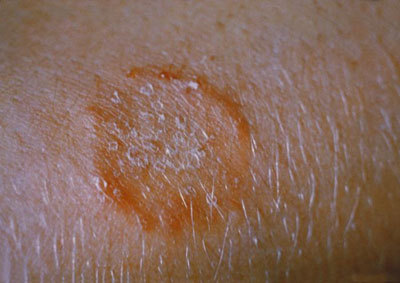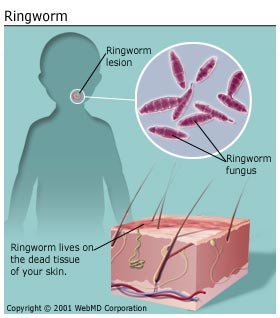 |
 |
 |
|---|
TINEA (RINGWORM)
 |
 |
 |
|---|
Although the words ringworm, jock itch, and athlete's foot may sound funny, if you're a teen with one of these skin infections, you're probably not laughing. If you've ever had one, you know that any of these infections can produce some pretty unpleasant symptoms. The good news is that tinea, the name for this category of common skin infections, is generally easy to treat. Read on to learn more about ringworm.
The Basics on Tinea Infections
Tinea (pronounced: tih-nee-uh) is the medical name for a group of related skin infections, including athlete's foot, jock itch, and ringworm. These infections are caused by several types of mold-like fungi called dermatophytes (pronounced: der-mah-tuh-fites) that live on the dead tissues of the skin, hair, and nails.
What Is Ringworm?
Ringworm, which isn't a worm at all, can affect not only the skin, but also the nails and scalp.
Ringworm of the skin starts as a red, scaly patch or bump. Ringworm tends to be very itchy and uncomfortable. Over time, it may begin to look like a ring or a series of rings with raised, bumpy, scaly borders (the center is often clear). This ring pattern gave ringworm its name, but not every person who's infected develops the rings.
When ringworm affects the feet it's known as athlete's foot, and the rash, which is usually between a person's toes, appears patchy. In fact, the rashes a person gets with athlete's foot and jock itch may not look like rings at all — they may be red, scaly patches.
Ringworm of the scalp may start as a small sore that resembles a pimple before becoming patchy, flaky, or scaly. It may cause some hair to fall out or break into stubbles. It can also cause the place where the infection is to become swollen, tender, and red.
Ringworm of the nails may affect one or more nails on a person's hands or feet. The nails may become thick, white or yellowish, and brittle. Ringworm of the nails is not too common before puberty, though.
Can I Prevent Ringworm?
The most common sources of the fungi that cause tinea infections are other people. Ringworm is contagious and is easily spread from one person to another, so avoid touching an infected area on another person. It's also possible to become infected from contact with animals, like cats and dogs.
It can be difficult to avoid ringworm because the dermatophyte fungi are very common. To protect yourself against infection, it can help to wear flip-flops on your feet in the locker room shower or at the pool, and to wash sports clothing regularly. Because fungi are on your skin, it's important to shower after contact sports and to wash your hands often, especially after touching pets.
If you discover a red, patchy, itchy area that you think may be ringworm, call your doctor.
How Is Ringworm Treated?
Fortunately, ringworm is fairly easy to diagnose and treat. Doctors usually can diagnose ringworm based on how it looks, but sometimes will scrape off a small sample of the flaky infected skin to test for fungus.
If you do have ringworm, your doctor will recommend an antifungal medication. A topical ointment or cream usually takes care of skin infections, but ringworm of the scalp or nails requires oral antifungal medication. Your doctor will decide which treatment is best for you.
Reviewed by: Patrice Hyde, MD
Date reviewed: February 2006
Resource: http://kidshealth.org/teen/